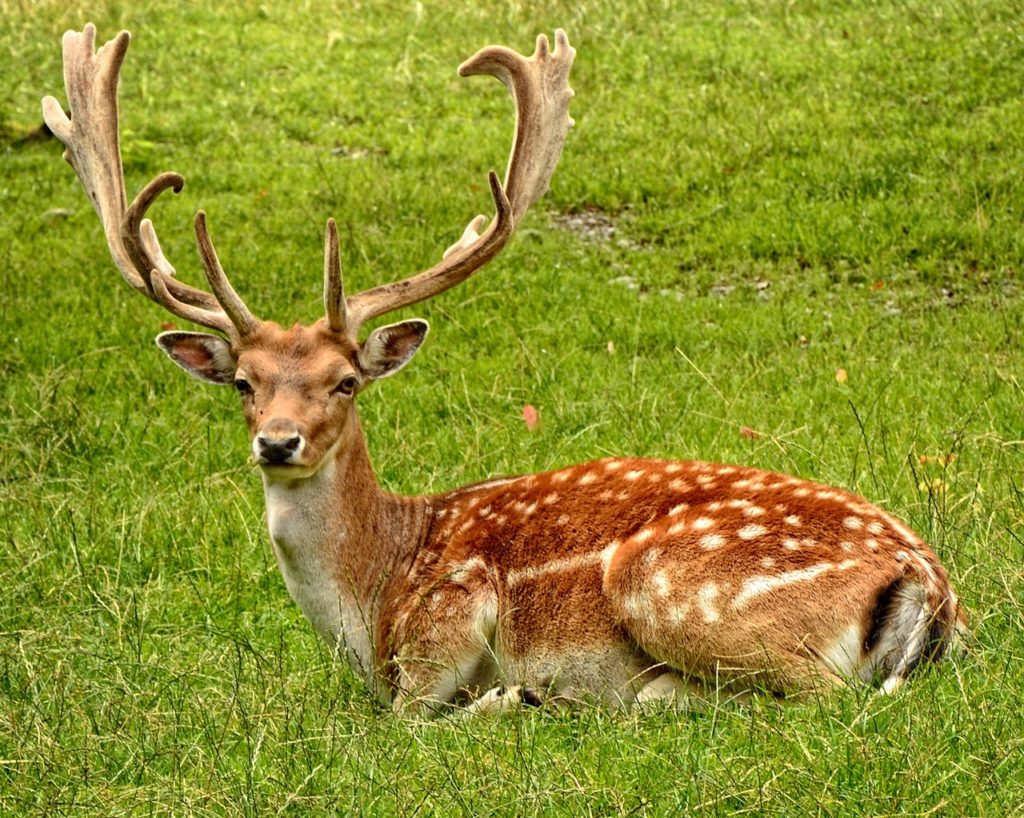
I learned this today. Antlers are made of bone and can grow up to 1 inch (2.5cm) a day.
Antlers are grown by the males (mostly) of the deer family. Deer are hoofed ruminants that have two large and two small hooves on each foot. There are 43 different species of deer. The smallest species of deer is the pudu, about 38cm tall at the shoulder, and the largest species is the moose, which can grow to about 2m at the shoulder. Both of these animals don’t appear to have anything in common, but they do. They both have antlers.
Antlers are made of bone, and they are one of the fastest growing tissues in the animal kingdom. Antlers are different to horns, which are made of keratin. Keratin is the same material that our fingernails are made of. Antlers are grown in the spring and shed in the winter. Horns are never shed.
The antler is attached to the skull but is not the skull. Male deer have a part on their skull called a pedicle. The pedicle is a bony part of the skull that is just under the skin of the forehead. The antlers grow from this point, but they are attached to it and not part of it.
In April or May, the pituitary gland starts to release growth hormones. It is triggered by the amount of daylight. These are the same hormones that make us grow. The antlers start growing out of the pedicle, but they are not bone yet. They are living tissue full of blood vessels. They are made of cartilage, nerve tissue, and blood vessels. They are covered in a hairy skin that grows with the antlers. It is very soft and is called “velvet”. Under the velvet, the living tissue starts to change to bone. It is divided into two types of bone. The outer layer is dense, compact bone and it gives the antlers strength and support. The inner layer is made of spongy bone with lots of blood vessels. The blood vessels transport nutrients and hormones to allow the antlers to keep growing.
The antlers keep growing as long as the deer can keep providing them with nutrients. They need protein, energy, and minerals. The deer get all these things from the plants they eat, but they also lick rocks to get minerals. They need a lot of minerals, but particularly calcium and phosphorous. Their bodies have to convert these minerals into a usable form, and they also take calcium from their own skeletons. Like us, deer skeletons are constantly rebuilding themselves, and this can provide a source of calcium for the antlers. While their antlers are growing, they can experience a 20% decline in the mineral content of their bones.
The antlers grow extremely quickly. Moose antlers grow the fastest. They grow by about 2.5cm and they add almost a pound of weight each day.
When the days start to shorten, the pituitary gland is stimulated again and this time it releases testosterone. This testosterone starts a mineralization process. Minerals flow along the blood vessels in the antlers and are deposited into the cartilage. The blood vessels themselves become solidified and the blood supply is cut off. This causes the antlers and the velvet skin that covers them to die. The velvet skin falls off over about 12 hours. The antlers are now solid, dead bone.
Finally, when the winter arrives, the antlers fall off. The deer lose them because they increase the deer’s surface area, and it would lose a lot of heat through them. This process starts with the deer reabsorbing some of the minerals from the antlers into its body. This is similar to the way trees reabsorb the chlorophyll from their leaves. Once the deer have absorbed enough minerals, cells called osteoclasts form at the point where the antler connects to the pedicle. These cells are active in our bodies when we have a healing broken bone. The osteoclasts degrade and weaken the bone until the antler breaks off under its own weight. The cycle begins again in the spring.
All male deer, except for the water deer, have antlers. They use them for a number of purposes, but the most important is to attract a mate. Studies have shown that female deer are attracted to the males with the largest antlers. Growing antlers requires a huge amount of energy and minerals. Deer that have large antlers are obviously strong enough and healthy enough to be able to find enough food and minerals. Therefore, they must make a good mate. Growing antlers takes so much of a deer’s energy, that they are considered to be a handicap.
So, deer start to grow antlers from the pedicle on the top of their heads in the spring. To begin with, the antlers are living tissue and are full of nerves, cartilage, and blood vessels. They are covered in a living skin called “velvet”. When they have finished growing, the blood vessels carry minerals into the antlers and they slowly harden, becoming dead bone. The velvet skin falls off. Towards the end of the year, the antlers weaken at the point where they join the pedicle until they fall off. Antlers grow extremely quickly, and they require the deer to find enormous amounts of food and minerals. Because deer that can find food can grow big antlers, they are used to attract a mate. And that is what I learned today.
Sources
https://www.mossyoak.com/our-obsession/blogs/deer/antler-genesis-how-deer-grow-antlers
https://en.wikipedia.org/wiki/Antler
https://onlinelibrary.wiley.com/doi/10.1111/j.0014-3820.2001.tb00794.x
https://animaldiversity.org/collections/mammal_anatomy/horns_and_antlers/
